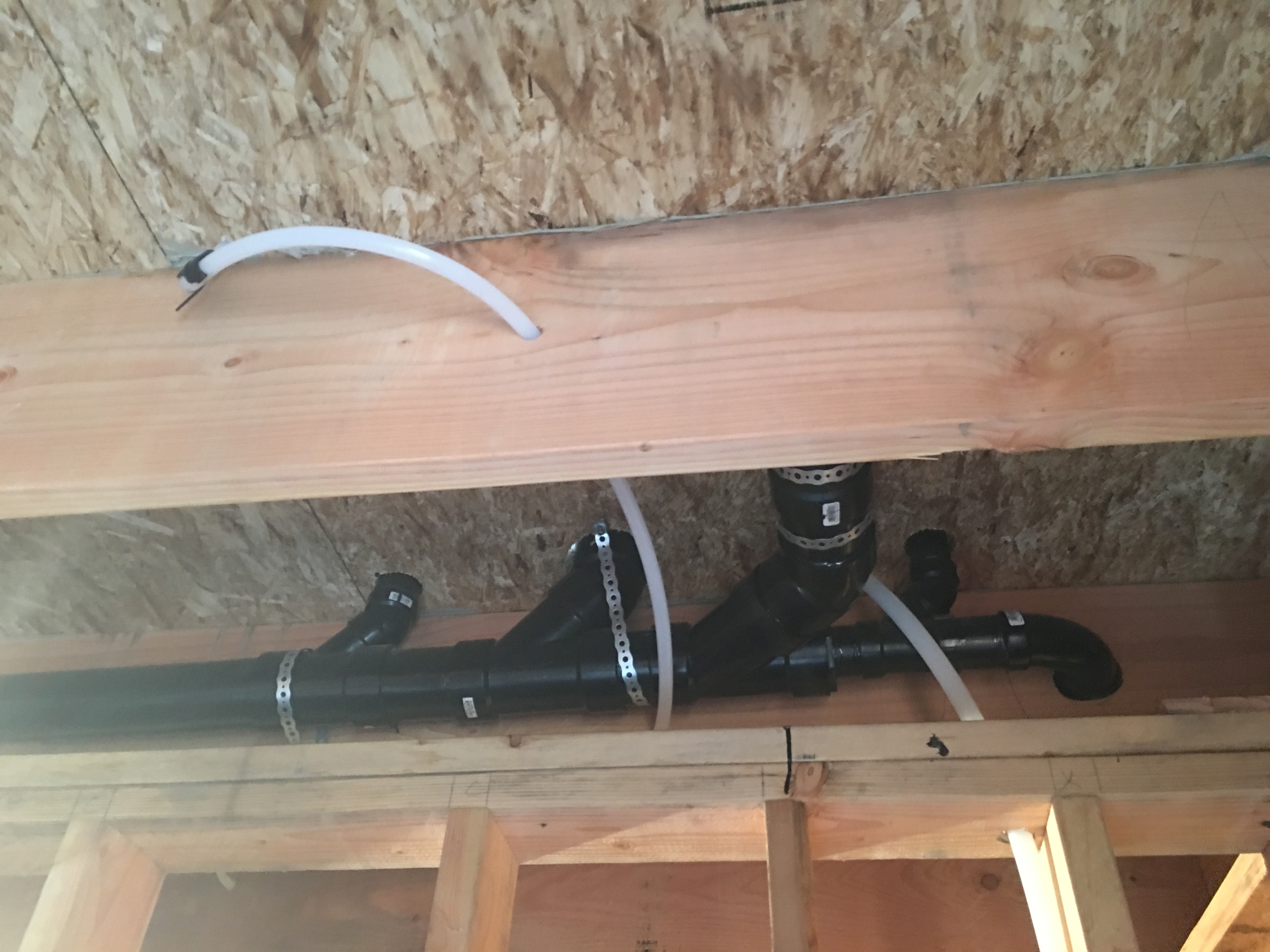Step 15 – Potable Water System
The DWV and water supply systems are inspected at the same time, during the plumbing inspection, so since I already had one of them complete I figured I might as well finish the other and get the inspection done. I decided to use PEX-A for supplying potable water to the house. Copper is the longest lasting, but also extremely susceptible to freezing and difficult to install. Galvanized steel and cast iron are also difficult to install and the most expensive options. This leaves PEX (cross-linked polyethylene), which is relatively inexpensive, easy to install, and can withstand freezing temperatures. Of over 20 different types of PEX on the market, PEX-A has been around the longest, and is by far the easiest to install. While it is more expensive than other types it is still cheaper than the metal options and has that freeze protection. Most importantly, fittings are connected using an expansion ring rather than a crimp ring.

An expansion ring is placed over the end of the PEX and then expanded using a specialized and expensive tool. The expanded PEX and ring is then slid over the male end of the fitting, which is about the same size as the unexpanded PEX. Within a few minutes, the PEX contracts to it’s original size, forming an incredibly strong seal with the fitting. Over time, the PEX continually tries to reach it’s original size, so the seal only becomes stronger. As an added benefit, the internal diameter of the fitting is the same size as the internal diameter of the original PEX, which maintains the flow rate of the water.

A crimp ring, on the other hand, works very differently. The fittings are smaller than the PEX, so the PEX can simply slide over the fitting. A crimp ring is placed over the fitting and PEX and then a tool is used to fold the edges of the crimp ring, reducing it’s size so it seals the PEX to the fitting. Over time, the crimp ring will attempt to return to it’s original size, reducing the strength of the seal. Additionally, the internal diameter is reduced as the water enters the fitting, and then expanded again as it exits. This has the same effect as a lane closure on a busy four lane freeway. The traffic reduces the flow rate in the PEX.

So PEX-A is the easiest to install, has the safest method for attaching fittings, and performs well in freezing temperatures. Although it isn’t the cheapest, I believe it has the best value, and that’s what Saving Sustainably is all about. The one major downside is that there have been a few scientific studies that say PEX-A is the most susceptible to chemicals leaching from the plastic into the water supply. However, you have to bear in mind that PEX has been used in Europe for decades now, and even California has completed their extensive studies on PEX and approved it for use. Water comes into contact with hundreds and thousands of chemicals and particles on the way from its source to your tap, and no study has shown definitevely that the amount of chemical possibly leached by PEX is more than a drop in the bucket. As with many decisions that need to be made in the home building process, there is rarely a perfect, high performing, inexpensive, environmentally friendly option. Compromises have to be made and in this case, I feel PEX provides the most upside with the least downside. That having said, I will be rigorously flushing the lines and installing filters before using the water. 
Just as with the DWV system, installing the water supply system requires extensive planning. You can see above how the water supply comes in from the right and splits up to three parts. The first covers all of the yard hydrants so I can water plants outside. The second goes to a manifold underneath the bathroom sink where it distributes cold water to all of the downstairs fixtures. The third goes upstairs to another manifold, where it distributes cold water to all of the upstairs fixtures and to the water heater. From the water heater, hot water exits and runs into two manifolds that distribute the hot water to all fixtures. The water heater I will be using is a Sanden Gen3 Heat Pump Water Heater, which uses environmentally friendly CO2 regrigerant and an air sourced heat pump to pull hot air from the outdoors and use it to heat the water. Although heat pump water heaters are becoming quite common, the Sanden system is unique in that the tank and heat pump are separate units. All the common heat pump water heaters are single units. This is important because with the single unit, you must choose to locate the system in either heated space, or the more common unheated space. Placing the unit in a heated, or conditioned, space means that it is pulling perfectly good hot air from your house to heat the water. If you live somewhere that is hot year round, this is a beneficial effect, but in most places this becomes highly inefficient in the winter. Placing the unit in unconditioned space means that both the hot water tank and piping must be heavily insulated to ensure the water doesn’t cool off considerably before it reaches your fixtures. The Sanden system gives you the best of both worlds!
Advice? Questions? I'd love to hear your feedback or help you out in any way I can!